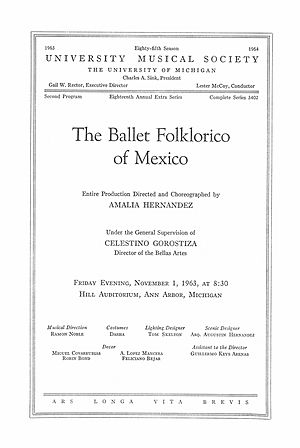Amalia Hernández facts for kids
Quick facts for kids
Amalia Hernández Navarro
|
|
|---|---|

Amalia Hernández (1973)
|
|
| Born |
Amalia Hernández Navarro
September 19, 1917 Mexico City, Mexico
|
| Died | November 5, 2000 (aged 83) Mexico City, Mexico
|
| Nationality | Mexican |
| Occupation | Choreographer |
| Years active | 1952-2000 |
| Relatives | Agustín Hernández Navarro (brother) Lamberto Hernández Navarro (brother) |

Amalia Hernández Navarro (born September 19, 1917 – died November 4, 2000) was a famous Mexican choreographer. She created the world-famous Ballet Folklórico de México.
Amalia was a pioneer in developing Baile Folklorico, which is traditional Mexican folk dance. In 1952, she started the Mexican Folkloric Ballet with only 8 dancers. By 1959, her dance group had grown to 60 performers! They were even asked to represent Mexico at the Pan American Games in Chicago, Illinois, in 1959. Amalia Hernández created more than 60 dances during her life.
Since 1960, her Ballet Folklórico de México has performed regularly. They have shows every Sunday morning and Wednesday evening at the beautiful Palace of Fine Arts in Mexico City. Amalia also founded the Folkloric Ballet School in Mexico City. Her brother, an architect named Agustín Hernández Navarro, designed the school building in 1968.
Contents
Who was Amalia Hernández?
Amalia Hernández was born in Mexico City on September 19, 1917. She grew up in a wealthy family. Her father was a successful businessman and was also involved in the military and politics. Amalia often said her mother helped her love for the arts. She had many lessons in art, singing, and music as a child. Her parents really supported her interest in dance. Her father even built a dance studio in their home! He once said that Amalia was "born to have" a career in dance.
When she was 17, Amalia joined the National School of Dance. This was a big step in her dance journey. However, she later left the school and got married. This put her dance career on hold for a short time. But her passion for dance was too strong. She soon started working as a teacher and choreographer at the Fine Arts National Institute.
Amalia felt that modern and European dance styles didn't quite fit her. She wanted to express her Mexican heritage through dance. So, she started focusing on traditional Mexican cultural dances. This is how she became involved with baile folklorico.
Amalia Hernández passed away on November 4, 2000, in Mexico City. She was 83 years old.
The Ballet Folklórico de México
Amalia Hernández started her own dance company, the Ballet Folklórico de México, in 1952. She wanted to explore her own creative ideas. The group began with just eight dancers. For their first show, Amalia presented a famous dance called "Melodies of Michoacan." In 1954, they got a chance to perform on a TV show called "Funcion de Gala."
This was a big turning point for the group. They performed a new dance every week on the show. They became very successful! Amalia became the director, and the group grew to twenty members. Their success caught the attention of the Mexican tourism department. The government supported her group, helping them tour North America to represent Mexico. The tours were a huge hit! By 1959, the group had sixty members. They were asked to perform at the Pan American Games in Chicago for Mexico.
After becoming famous across the country, Amalia and her company worked even harder. They created 40 different dances in the 1960s alone. Amalia became a cultural icon. She choreographed about 70 dances in total, and her company performed all over the world. The Ballet Folklórico de México has performed more than 15,000 times for over 22 million people! They even performed for John F. Kennedy when he was president.
Why Amalia Hernández is Important
Amalia Hernández always spoke about her deep love for Mexico. She made sure to highlight Mesoamerican cultures in her dancing. These are the ancient cultures that existed in Mexico before Europeans arrived. Her goal was to show how diverse Mexico is. She also wanted to explore pre-Columbian traditions.
Amalia became a symbol of "Mexicanidad," which means Mexican identity. She worked hard to include indigenous dances. This showed a true picture of Mexican identity, not just one influenced by Western cultures.
Thanks to Amalia Hernández, the unique indigenous image of Mexico is now known worldwide. This has helped people recognize Mexico's special culture. It has also made Mexicans proud of their folklorico dancing. Amalia also showed the different regions of Mexico. Her dances focused on specific areas and their cultural traditions. For example, her famous dances like "Melodies of Michoacan," "Deer Dance," "Jalisco," and "Fandangos" all highlight different parts of Mexico and their unique cultures.
On September 19, 2017, a special Google Doodle was made to celebrate Amalia Hernández's 100th birthday.
See also
 In Spanish: Amalia Hernández para niños
In Spanish: Amalia Hernández para niños
- Baile Folklorico
- Culture of Mexico
- Ballet Folklorico de Mexico

